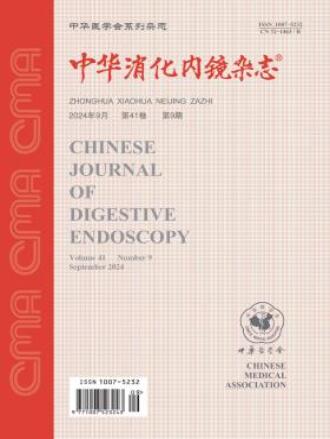光学相干断层扫描预测早期食管癌侵袭深度的前瞻性研究
引用次数: 0
摘要
目的探讨光学相干断层扫描(OCT)对早期食管癌(EEC)侵袭深度的预测价值,并比较OCT与放大内镜-窄带成像(ME-NBI)的临床应用价值。方法28例经内镜下粘膜下剥离术(ESD)前诊断为EEC并接受OCT和ME-NBI检查的患者进行前瞻性研究。在OCT和ME-NBI图像的基础上,实时预测脑电图侵袭深度。以术后病理结果为金标准,比较OCT与ME-NBI评价脑电图侵袭深度的准确性。并分析了手术时间和评估过程中并发症的发生率。结果OCT和ME-NBI预测28例脑电图患者侵深的总体准确率分别为67.9%(19/28)和75.0%(21/28),两者差异无统计学意义(P < 0.05)。OCT与ME-NBI区分上皮/固有层粘膜(EP/LPM)病变的准确率分别为78.9%(15/19)和68.4%(13/19),差异无统计学意义(P < 0.05)。OCT的手术时间明显短于ME-NBI(6.0±2.9 min VS 16.3±5.4 min, P<0.001)。结论OCT预测脑电图侵袭深度和区分EP/LPM病变的能力与ME-NBI相当。此外,OCT需要更短的程序时间进行评估。关键词:层析成像;光学相干;食管肿瘤;侵入深度;窄带放大内镜;精度本文章由计算机程序翻译,如有差异,请以英文原文为准。
A prospective study of optical coherence tomography for predicting invasion depth of early esophageal cancer
Objective
To evaluate optical coherence tomography(OCT)for predicting invasion depth of early esophageal cancer(EEC) and to compare OCT and magnifying endoscopy-narrow band imaging (ME-NBI)in clinical performance.
Methods
Twenty-eight patients who were diagnosed with EEC and accepted OCT and ME-NBI before endoscopic submucosal dissection(ESD)were enrolled in this prospective study. On the basis of OCT and ME-NBI images, real-time prediction of EEC invasion depth was conducted. Postoperative pathological results were taken as golden standard to compare the accuracy of OCT and ME-NBI in evaluation of EEC invasion depth. The procedure time and incidence of complications during evaluation process were also analyzed.
Results
The overall accuracy of OCT and ME-NBI in predicting invasion depth of 28 EEC patients were 67.9% (19/28) and 75.0% (21/28) respectively, with no significant difference(P>0.05). The accuracy of OCT and ME-NBI in distinguishing lesions located in epithelium/lamina propria mucosa (EP/LPM) lesions were 78.9%(15/19) and 68.4% (13/19), with no significant difference(P>0.05). The procedure time of OCT was significantly shorter than that of ME-NBI (6.0±2.9 min VS 16.3±5.4 min, P<0.001).
Conclusion
The ability of OCT to predict invasion depth of EEC and distinguish lesions located in the EP/LPM is comparable with that of ME-NBI. Besides, OCT requires shorter procedure time for evaluation.
Key words:
Tomography, optical coherence; Esophageal neoplasm; Invasion depth; Magnifying endoscopy with narrow band imaging; Accuracy
求助全文
通过发布文献求助,成功后即可免费获取论文全文。
去求助
来源期刊
CiteScore
0.10
自引率
0.00%
发文量
7555
期刊介绍:
Chinese Journal of Digestive Endoscopy is a high-level medical academic journal specializing in digestive endoscopy, which was renamed Chinese Journal of Digestive Endoscopy in August 1996 from Endoscopy.
Chinese Journal of Digestive Endoscopy mainly reports the leading scientific research results of esophagoscopy, gastroscopy, duodenoscopy, choledochoscopy, laparoscopy, colorectoscopy, small enteroscopy, sigmoidoscopy, etc. and the progress of their equipments and technologies at home and abroad, as well as the clinical diagnosis and treatment experience.
The main columns are: treatises, abstracts of treatises, clinical reports, technical exchanges, special case reports and endoscopic complications.
The target readers are digestive system diseases and digestive endoscopy workers who are engaged in medical treatment, teaching and scientific research.
Chinese Journal of Digestive Endoscopy has been indexed by ISTIC, PKU, CSAD, WPRIM.

 求助内容:
求助内容: 应助结果提醒方式:
应助结果提醒方式:


